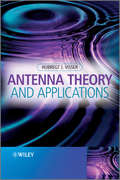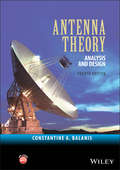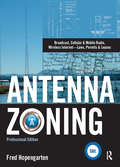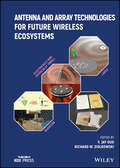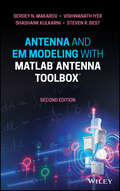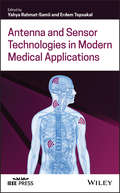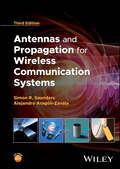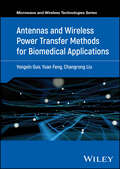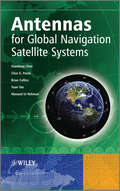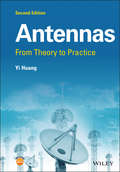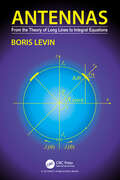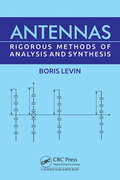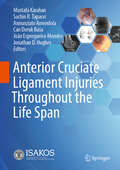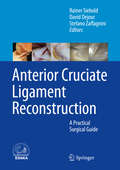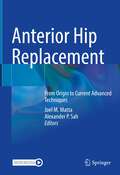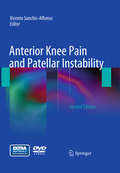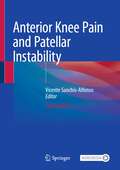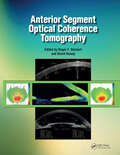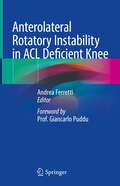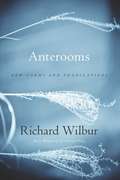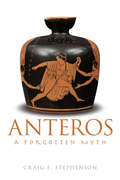- Table View
- List View
Antenna Theory and Applications
by Hubregt J. VisserThis comprehensive text on antenna theory explains the origin of radiation and discusses antenna parameters in-depthThis book offers an in-depth coverage of fundamental antenna theory, and shows how to apply this in practice. The author discusses electromagnetic radiation and antenna characteristics such as impedance, radiation pattern, polarization, gain and efficiency. In addition, the book provides readers with the necessary tools for analyzing complex antennas and for designing new ones. Furthermore, a refresher chapter on vector algebra, including gradient, divergence and curl operation is included. Throughout the book ample examples of employing the derived theory are given and all chapters are concluded with problems, giving the reader the opportunity to test his/her acquired knowledge.Key Features:Covers the mathematical and physical background that is needed to understand electromagnetic radiation and antennasDiscusses the origin of radiation and provides an in-depth explanation of antenna parametersExplores all the necessary steps in antenna analysis allowing the reader to understand and analyze new antenna structuresContains a chapter on vector algebra, which is often a stumbling block for learners in this fieldIncludes examples and a list of problems at the end of each chapterAccompanied by a website containing solutions to the problems (for instructors) and CST modeling files (www.wiley.com/go/visser_antennasThis book will serve as an invaluable reference for advanced (last year Bsc, Msc) students in antenna and RF engineering, wireless communications, electrical engineering, radio engineers and other professionals needing a reference on antenna theory. It will also be of interest to advanced/senior radio engineers, designers and developers.
Antenna Theory and Microstrip Antennas
by D. G. FangAntenna Theory and Microstrip Antennas offers a uniquely balanced analysis of antenna fundamentals and microstrip antennas. Concise and readable, it provides theoretical background, application materials, and details of recent progress. Exploring several effective design approaches, this book covers a wide scope, making it an ideal hands-on resource for professionals seeking a refresher in the fundamentals. It also provides the basic grounding in antenna essentials that is required for those new to the field.The book’s primary focus is on introducing practical techniques that will enable users to make optimal use of powerful commercial software packages and computational electromagnetics used in full wave analysis and antenna design. Going beyond particular numerical computations to teach broader concepts, the author systematically presents the all-important spectral domain approach to analyzing microstrip structures including antennas. In addition to a discussion of near-field measurement and the high-frequency method, this book also covers:Elementary linear sources, including Huygen’s planar element, and analysis and synthesis of the discrete and continuous arrays formed by these elementary sourcesThe digital beam-forming antenna and smart antennaCavity mode theory and related issues, including the design of irregularly shaped patches and the analysis of mutual couplingBased on much of the author’s own internationally published research, and honed by his years of teaching experience, this text is designed to bring students, engineers, and technicians up to speed as efficiently as possible. This text purposefully emphasizes principles and includes carefully selected sample problems to ease the process of understanding the often intimidating area of antenna technology. Paying close attention to this text, you will be able to confid
Antenna Theory: Analysis And Design
by Constantine A. BalanisThis book introduces the fundamental principles of antenna theory and explains how to apply them to the analysis, design, and measurements of antennas. Due to the variety of methods of analysis and design, and the different antenna structures available, the applications covered in this book are made to some of the most basic and practical antenna configurations. Among these antenna configurations are linear dipoles; loops; arrays; broadband antennas; aperture antennas; horns; microstrip antennas; and reflector antennas. The text contains sufficient mathematical detail to enable undergraduate and beginning graduate students in electrical engineering and physics to follow the flow of analysis and design. Readers should have a basic knowledge of undergraduate electromagnetic theory, including Maxwell’s equations and the wave equation, introductory physics, and differential and integral calculus.
Antenna Zoning: Broadcast, Cellular & Mobile Radio, Wireless Internet- Laws, Permits & Leases
by Fred HopengartenIf you are building, adding to, modifying, or even upgrading a commercial antenna system, and most especially if you hope to erect a new tower, then zoning laws apply to you. Antenna Zoning enables you to successfully navigate structure regulations, permitting, and even lease negotiations. Whether you are involved with broadcast radio or television, cellular telephone, paging, wireless internet service, or other telecommunications, this book is a must-have before you begin work on the project. Author Fred Hopengarten is a specialized communications lawyer with extensive experience in antenna and tower regulation, and has been involved in many high-profile zoning cases. His first-hand experience comes to you in this book with lessons learned, case studies, examples, and material you can use presented in an easy-to-understand manner.
Antenna and Array Technologies for Future Wireless Ecosystems
by Yingjie Jay GuoANTENNA AND ARRAY TECHNOLOGIES FOR FUTURE WIRELESS ECOSYSTEMS Discover a timely and accessible resource on the latest antenna research driving new developments in the field In Antenna and Array Technologies for Future Wireless Ecosystems, distinguished academics and authors Drs. Y. Jay Guo and Richard W. Ziolkowski deliver a cutting-edge resource for researchers, academics, students, and engineers who need the latest research findings on the newest challenges facing antenna designers who will be creating the technology that drives future 6G and beyond wireless systems and networks. This timely and impactful book offers the fundamental knowledge that will facilitate new research activities in the antennas and applied electromagnetics communities, and conveys innovative and practical solutions to many wireless industry problems. Its international cohort of leading authors delivers their findings on a variety of advanced topics in antenna and array research, including metasurface antennas; electrically small directive antennas; RF, millimeter-wave and THz antennas and arrays; atom-based sensors, and arrays of quantum emitters. The book also includes resources that cover the important topics: A thorough introduction to various intelligent and low-cost beam scanning, beamforming and beam-reconfigurable array technologies to support dynamic networking of future systems An exploration of advanced techniques for analyzing large arrays, as well as an examination of advanced antenna-in-package technologies for future mm-wave systems Discussions of the latest research on electrically small and extremely large hybrid antenna arrays, and photonic beamforming networks to address spectrum scarcity in future systems Low form-factor, low energy-consumption, and wireless power transfer antennas for the Internet of Things (IoT) This book is the companion of the Wiley book by the same authors, Advanced Antenna Array Engineering for 6G and Beyond Wireless Communications. Perfect for antenna engineers in academia and industry, Antenna and Array Technologies for Future Wireless Ecosystems will also be an essential resource in the libraries of senior undergraduate and graduate students studying antenna engineering applied electromagnetics and seeking a one-stop reference for state-of-the-art global antenna and antenna array research activities.
Antenna and EM Modeling with MATLAB Antenna Toolbox
by Sergey N. Makarov Vishwanath Iyer Shashank Kulkarni Steven R. BestAntenna and EM Modeling with MATLAB Antenna Toolbox™ is a textbook on antennas intended for a one semester course. The core philosophy is to introduce the key antenna concepts and follow them up with full-wave modeling and optimization in the MATLAB Antenna Toolbox. Such an approach will enable immediate testing of theoretical concepts by experimenting in software. It also provides the direct path to independent research work. The fundamental families of antennas – dipoles, loops, patches, and traveling wave antennas – are discussed in detail, together with the antenna arrays. Internally, the toolbox uses the Method of Moments (the method of integral equation) for modeling metal and metal-dielectric antennas. Rao-Wilton-Glisson basis functions on triangular facets are used for the metal parts and edge basis functions on tetrahedra are used for the dielectric parts. Accurate semi-analytical calculations of near-field interactions assure good solution accuracy.
Antenna and Sensor Technologies in Modern Medical Applications (Wiley - IEEE)
by Yahya Rahmat-Samii Erdem TopsakalA guide to the theory and recent development in the medical use of antenna technology Antenna and Sensor Technologies in Modern Medical Applications offers a comprehensive review of the theoretical background, design, and the latest developments in the application of antenna technology. Written by two experts in the field, the book presents the most recent research in the burgeoning field of wireless medical telemetry and sensing that covers both wearable and implantable antenna and sensor technologies. The authors review the integrated devices that include various types of sensors wired within a wearable garment that can be paired with external devices. The text covers important developments in sensor-integrated clothing that are synonymous with athletic apparel with built-in electronics. Information on implantable devices is also covered. The book explores technologies that utilize both inductive coupling and far field propagation. These include minimally invasive microwave ablation antennas, wireless targeted drug delivery, and much more. This important book: Covers recent developments in wireless medical telemetry Reviews the theory and design of in vitro/in vivo testing Explores emerging technologies in 2D and 3D printing of antenna/sensor fabrication Includes a chapter with an annotated list of the most comprehensive and important references in the field Written for students of engineering and antenna and sensor engineers, Antenna and Sensor Technologies in Modern Medical Applications is an essential guide to understanding human body interaction with antennas and sensors.
Antenna-in-Package Technology and Applications (Wiley - IEEE)
by Duixian Liu Yueping ZhangA comprehensive guide to antenna design, manufacturing processes, antenna integration, and packaging Antenna-in-Package Technology and Applications contains an introduction to the history of AiP technology. It explores antennas and packages, thermal analysis and design, as well as measurement setups and methods for AiP technology. The authors—well-known experts on the topic—explain why microstrip patch antennas are the most popular and describe the myriad constraints of packaging, such as electrical performance, thermo-mechanical reliability, compactness, manufacturability, and cost. The book includes information on how the choice of interconnects is governed by JEDEC for automatic assembly and describes low-temperature co-fired ceramic, high-density interconnects, fan-out wafer level packaging–based AiP, and 3D-printing-based AiP. The book includes a detailed discussion of the surface laminar circuit–based AiP designs for large-scale mm-wave phased arrays for 94-GHz imagers and 28-GHz 5G New Radios. Additionally, the book includes information on 3D AiP for sensor nodes, near-field wireless power transfer, and IoT applications. This important book: • Includes a brief history of antenna-in-package technology • Describes package structures widely used in AiP, such as ball grid array (BGA) and quad flat no-leads (QFN) • Explores the concepts, materials and processes, designs, and verifications with special consideration for excellent electrical, mechanical, and thermal performance Written for students in electrical engineering, professors, researchers, and RF engineers, Antenna-in-Package Technology and Applications offers a guide to material selection for antennas and packages, antenna design with manufacturing processes and packaging constraints, antenna integration, and packaging.
Antennas Designs for NFC Devices
by Dominique ParetNear-field communication (NFC) enables the exchange of information between close devices. The antenna is the indispensable element to transform an electronic device into an NFC system. For both theory and practice, this book presents in detail the design technologies of different antennas. They must meet the NFC ISO 18 092 and 21 481 standards as well as specifications by the NFC Forum for industrial applications, by EMVCo for banking applications and payments, and by CEN for public transport. In a particularly pedagogic way, Antenna Designs for NFC Devices enables designers of communicating object systems and the Internet of Things (IoT) to have access to the mysteries of the design of NFC antennas.
Antennas and Propagation for Wireless Communication Systems
by Simon R. Saunders Alejandro A. Aragón-ZavalaComprehensive resource describing both fundamentals and practical industry applications of antennas and radio propagation employed in modern wireless communication systems The newly revised and thoroughly updated Third Edition of this classic and popular text, Antennas and Propagation for Wireless Communication Systems addresses fundamentals and practical applications of antennas and radio propagation commonly used in modern wireless communication systems, from the basic electromagnetic principles to the characteristics of the technology employed in the most recent systems deployed, with an outlook of forthcoming developments in the field. Core topics include fundamental electromagnetic principles underlying propagation and antennas, basic concepts of antennas and their application to specific wireless systems, propagation measurement, modelling, and prediction for fixed links, macrocells, microcells, femtocells, picocells, megacells, and narrowband and wideband channel modelling with the effect of the channel on communication system performance. Worked examples and specific assignments for students are presented throughout the text (with a solutions manual available for course tutors), with a dedicated website containing online calculators and additional resources, plus details of simple measurements that students can perform with off-the-shelf equipment, such as their laptops and a Wi-Fi card. This Third Edition of Antennas and Propagation for Wireless Communication Systems has been thoroughly revised and updated, expanding on and adding brand new coverage of sample topics such as: Maxwell’s equations and EM theory, multiple reflections as propagation mechanisms, and waveguiding HAPS (High Altitude Platforms) propagation, design and noise considerations of earth stations, macrocell models, and cellular base station site engineeringFSS (frequency selective surfaces), adaptive antenna theory developments (massive and distributed MIMO in particular), and how to process raw data related to channel measurements for mobile radio systemsThe techniques used in mobile systems spanning the latest 4G, 5G and 6G technology generations A wider range of frequencies, extending from HF, VHF and UHF up to the latest millimetre wave and sub terahertz bands With comprehensive coverage of foundational subject matter as well as major recent advancements in the field, Antennas and Propagation for Wireless Communication Systems is an essential resource for undergraduate and postgraduate students, researchers, and industry engineers in related disciplines.
Antennas and Wireless Power Transfer Methods for Biomedical Applications (Microwave and Wireless Technologies Series)
by Yuan Feng Yongxin Guo Changrong LiuAntennas and Wireless Power Transfer Methods for Biomedical Applications Join the cutting edge of biomedical technology with this essential reference The role of wireless communications in biomedical technology is a significant one. Wireless and antenna-driven communication between telemetry components now forms the basis of cardiac pacemakers and defibrillators, cochlear implants, glucose readers, and more. As wireless technology continues to advance and miniaturization progresses, it’s more essential than ever that biomedical research and development incorporate the latest technology. Antennas and Wireless Power Transfer Methods for Biomedical Applications provides a comprehensive introduction to wireless technology and its incorporation into the biomedical field. Beginning with an introduction to recent developments in antenna and wireless technology, it analyzes the major wireless systems currently available and their biomedical applications, actual and potential. The result is an essential guide to technologies that have already improved patient outcomes and increased life expectancies worldwide. Readers will also find: Authored by internationally renowned researchers of wireless technologies Detailed analysis of CP implantable antennas, wearable antennas, near-field wireless power, and more Up to 100 figures that supplement the text Antennas and Wireless Power Transfer Methods for Biomedical Applications is a valuable introduction for biomedical researchers and biomedical engineers, as well as for research and development professionals in the medical device industry.
Antennas for Global Navigation Satellite Systems
by Brian Collins Xiaodong Chen Yuan Yao Clive G. Parini Masood Ur RehmanThis book addresses the fundamentals and practical implementations of antennas for Global Navigation Satellite Systems (GNSS)In this book, the authors discuss the various aspects of GNSS antennas, including fundamentals of GNSS, design approaches for the GNSS terminal and satellite antennas, performance enhancement techniques and effects of user's presence and surrounding environment on these antennas. In addition, the book will provide the reader with an insight into the most important aspects of the GNSS antenna technology and lay the foundations for future advancements. It also includes a number of real case studies describing the ways in which antenna design can be adapted to conform to the design constraints of practical user devices, and also the management of potential adverse interactions between the antenna and its platform.Key Features:Covers the fundamentals and practical implementations of antennas for Global Navigation Satellite Systems (GNSS)Describes technological advancements for GPS, Glonass, Galileo and CompassAims to address future issues such as multipath interference, in building operation, RF interference in mobileIncludes a number of real case studies to illustrate practical implementation of GNSSThis book will be an invaluable guide for antenna designers, system engineers, researchers for GNSS systems and postgraduate students (antennas, satellite communication technology). R&D engineers in mobile handset manufacturers, spectrum engineers will also find this book of interest.
Antennas for Industrial and Medical Applications with Optimization Techniques for Wireless Communication
by R. Nagarajan S. KannadhasanThe text begins by covering the fundamental concepts and new advances in the field of antenna theory, antenna hardware, and propagation. It further explains the designing of metamaterials microstrip patch antennas for medical applications, photonic crystals of millimeter wave signals for 5G communications, dual-band miniaturized circular antennas for wireless networks, and ultra-thin compact flexible antennas for wearable applications.This book: Presents the design and development of S-shaped and T-shaped microstrip path antennas for industrial applications. Highlights the use of W-shaped and metamaterials microstrip patch antennas for medical applications. Covers photonic crystals of millimeter wave signals for 5G communications. Showcases the importance of compact and wideband slot antenna for wireless communications. Illustrates the design of an ultra-thin compact flexible antenna for wearable applications. It is primarily written for senior undergraduates, graduate students, and academic researchers in the fields of electrical engineering, electronics and communications engineering, antenna design, and microwave engineering.
Antennas: From Theory to Practice
by Yi HuangAntennas From Theory to Practice Comprehensive coverage of the fundamentals and latest developments in antennas and antenna design In the newly revised Second Edition of Antennas: From Theory to Practice, renowned researcher, engineer, and author Professor Yi Huang delivers comprehensive and timely coverage of issues in modern antenna design and theory. Practical and accessible, the book is written for engineers, researchers, and students who work with radio frequency/microwave engineering, radar, and radio communications. The book details the basics of transmission lines, radiowaves and propagation, antenna theory, antenna analysis and design using industrial standard design software tools and the theory of characteristic modes, antenna measurement equipment, facilities, and techniques. It also covers the latest developments in special topics, like small and mobile antennas, wide- and multi-band antennas, automotive antennas, RFID, UWB, metamaterials, reconfigurable and MIMO antennas, and more. The new edition includes up to date information on a wide variety of newly relevant topics and trends, like adaptive impedance matching, the theory of characteristic modes, antenna materials and fabrication processes, and over-the-air (OTA) antenna system measurements. Many questions and examples are provided which enhances the learning experience. The book covers: An introduction to circuit concepts and transmission lines, including lumped and distributed element systems, transmission line theory, and the Smith Chart An exploration of field concepts and radiowaves, including wave equations and solutions and radiowave propagation mechanisms, characteristics, and models Discussions of antenna basics and popular antennas, including wire-type antennas, aperture-type antennas, and antenna arrays Information about antenna manufacturing and measurements, including antenna measurement facilities and methods The use of industrial standard simulation tools for antenna design and analysis Perfect for engineers and researchers who work in RF engineering or radar and radio communications, Antennas: From Theory to Practice, Second Edition will also earn a place on the bookshelves of university students seeking a concise and practical introduction to the basics of antennas and antenna design.
Antennas: From the Theory of Long Lines to Integral Equations
by Boris LevinThis book describes both known and new results. In the sections devoted to the use of integral equations for the current in a linear metal radiator, the focus is on Leontovich's equation. An advantage of this equation is the simplicity of the solution and the absence of the argument φ in it because the integration over φ already performed. The refined solution makes it possible to determine the total sum of the series for the current, which is close to the known solution including only the first terms. The results of the synthesis of different types of antennas with capacitive loads are presented, which makes it possible to implement Hallen's hypothesis about the usefulness of applying such loads to create an in-phase current distribution in antennas and to obtain required characteristics.New results include the widespread use of the complex potential method in relation to the calculation of capacitive structures in homogeneous and inhomogeneous media, antenna patterns and flows of electrical fields between antenna elements and in the surrounding space. In particular, the analysis of field flows makes it possible to substantiate a rigorous method for analyzing microstrip antennas. The characteristics of antennas in various conditions of their installation are considered and compared. The results of the use of multi-floors structures that provide in the wide frequency range the radiation in direction perpendicular to the antenna axis, and structures that make it possible to reduce the mutual influence of antennas located at different heights on a common mast are described.
Antennas: Rigorous Methods of Analysis and Synthesis
by Boris LevinThe book comprises a new method of solving the integral equation of Leontovich, the most rigorous and most effective equation for the current in thin linear antennas. The book describes the features of the new method in its application in various types of antennas. It considers new ways of analyzing antennas, in particular in the calculation of an antenna gain based on main radiation patterns and the calculation of the directional characteristics of radiators with known distribution of current amplitude. The method of electrostatic analogy proposed by the author, provides the base for comparison of electromagnetic fields of high-frequency currents and electrostatic charges located on linear conductors to improve the directional characteristics of log-periodic and director-type antennas. A new approach to the analysis of the electrical characteristics of a microstrip antenna, which allows expansion of its operation range, is substantiated and developed. New results of antenna synthesis are obtained. The second part of the book is devoted to specific types of antennas (the author had a significant role in their creation). Particular attention is given to ship antennas for different frequency ranges. The book is intended for professionals, working in electrodynamics and those working on development, placement and exploitation of antennas. It will be useful for lecturers (university-level professors), teachers, students of radio engineering and researchers working in various fields of radio electronics and interested in an in-depth study of theoretical problems and designs f antennas. It can also be used for short university courses.
Anterior Cruciate Ligament Injuries Throughout the Life Span
by Mustafa Karahan João Espregueira-Mendes Annunziato Amendola Sachin R. Tapasvi Can Doruk Basa Jonathan D. HughesThis book uniquely addresses anterior cruciate ligament (ACL) injury – one of the leading issues in orthopedic sports medicine – throughout the lifespan, with a focus on differences depending on age and activity levels.It provides readers with fundamental knowledge, such as anatomy histology and biomechanics, as well as with diagnostic criteria specific for each age group and activity level – from pediatrics through adolescents to adults and high-level athletes. Furthermore, international experts present diverse prevention and injury management criteria as well as state-of-the-art surgical techniques based on the expectations of each age and lifestyle group. Designed to be an easy-to-read reference guide, this book presents fundamental concepts in the management of ACL injuries. It appeals to a broad readership ranging from orthopedic surgeons, residents and sports physicians to athletic trainers and all professionals involved in rehabilitation following ACL injuries.
Anterior Cruciate Ligament Reconstruction: A Practical Surgical Guide
by Stefano Zaffagnini David Dejour Rainer SieboldThis practical and instructional guidebook, written by international experts in anterior cruciate ligament (ACL) reconstruction, covers all challenging aspects of ACL rupture in the acute and chronic setting. It covers the latest, spectacular anatomical findings, treatment of partial ACL tears, various techniques for single- and double-bundle ACL reconstruction, and complex ACL revision surgery. Important surgical steps are clearly described with the help of instructive, high-quality photographs. Important tips, tricks, and pitfalls are highlighted and intra- and postoperative complications, rehabilitation, and prevention of re-rupture are discussed. All authors are prominent and experienced ACL surgeons.
Anterior Hip Replacement: From Origin to Current Advanced Techniques
by Joel M. Matta Alexander P. SahAnterior hip replacement is a surgical approach that has dramatically changed the landscape of modern hip replacement. The approach is common to orthopedic trauma surgery, but it has been rapidly adopted in recent years for hip replacement as well. Its proposed benefits as a muscle-sparing surgery include less tissue trauma, faster recovery, and fewer hip precautions. While the technique can be challenging during initial learning and early adoption, the approach continues to increase in utilization in the U.S. every year because of these benefits. Understanding the initial development of the anterior surgical approach for hip replacement creates the foundation to better understand its modern clinical benefits and possibilities with advanced techniques. Furthermore, a detailed description of the reasoning behind the continued developments of the anterior approach helps in understanding the key elements needed to obtain the most successful outcomes.With the continued adoption of this technically challenging technique, there is a need for a comprehensive resource for newly adopting surgeons and surgeons in training, but also for experienced surgeons looking to enhance their skill sets. Written by experts in the field, this book presents the tips and tricks learned after years of experience by a wide spectrum of surgeons. Parts 1 and 2 describe the origin and background of the anterior approach for hip replacement, with early lessons learned, important tips when training others, and how to master the operating table and c-arm. Parts 3 and 4 cover hip biomechanics and variations on techniques and technologies, respectively, while part 5 is a unique compilation of surgeons' perspectives on managing common aspects of the approach. Revision surgery is described in part 6, and future directions for the technique are discussed in part 7, along with emerging navigation and technologies.Every year, there is an increasing number of orthopedic surgeons learning and adopting the anterior hip approach who would benefit from the resources in this book, which will serve as a critical learning tool for training surgeons and also as the go-to reference for optimizing current use and advancing future possibilities of the approach.
Anterior Knee Pain and Patellar Instability
by Vicente Sanchis-AlfonsoA multitude of leading international authorities provide fresh insights and approaches for patient evaluation and treatment of Anterior knee pain syndrome and patellofemoral instability. Included are new chapters featuring clinical cases and detailed descriptions of the most important surgical techniques used for the knee extensor mechanism, each being described by the surgeon who developed it. The book is divided in four sections, the first section focuses on the etiopathogenic bases, the second section focuses on emerging technologies, the third section includes difficult clinical cases studied, and the fourth section provides a description of the most important surgical techniques for the knee extensor mechanism.
Anterior Knee Pain and Patellar Instability
by Vicente Sanchis-AlfonsoThis textbook provides an authoritative reference on one of the most problematic entities in the pathology of the knee. Throughout the text, esteemed international experts highlight their clinical insights for ensuring optimal non-surgical and surgical outcomes when treating anterior knee pain and patellar instability. The chapters are revised with the latest updates and new chapters are featured focusing upon robotic-assisted patellofemoral replacement, predictive diagnostic models in anterior knee pain patients based on artificial intelligence, brain network functional connectivity in anterior knee pain patients, and many other hot topics in the field. Anterior Knee Pain and Patellar Instability, 3rd Edition is an essential, multi-disciplinary textbook for all levels of orthopedic surgeons, physiotherapists, radiologists, biologists, pathologists, and bioengineers, who wish to learn more about this complex pathology that affects both young and older patients.
Anterior Segment Optical Coherence Tomography
by David Huang Roger SteinertHigh-speed anterior segment optical coherence tomography (OCT) offers a non-contact method for high resolution cross-sectional and three-dimensional imaging of the cornea and the anterior segment of the eye. As the first text completely devoted to this topic, Anterior Segment Optical Coherence Tomography comprehensively explains both the scientific principles and the clinical applications of this exciting and advancing technology.Anterior Segment Optical Coherence Tomography enhances surgical planning and postoperative care for a variety of anterior segment applications by expertly explaining how abnormalities in the anterior chamber angle, cornea, iris, and lens can be identified and evaluated using the Visante OCT™.Inside Anterior Segment Optical Coherence Tomography, Dr. Roger Steinert and Dr. David Huang, along with 22 of the field's leading professionals, provide a wealth of useful clinical and physiological material about this new diagnostic imaging technique. Valuable images are included to assist in the pre- and postoperative assessment of various anterior segment disorders. Additionally, this unique resource contains detailed information on biometric measurements to enhance diagnostic capability.On the leading edge of anterior segment imaging: Mapping of corneal thickness and keratoconus evaluation Measurement of LASIK flap and stromal bed thickness Visualization and measurement of anterior chamber angle and diagnosis of narrow angle glaucoma Measuring the dimensions of the anterior chamber and assessing the fit of intraocular lens implants Visualizing and measuring the results of corneal implants and lamellar procedures Imaging through corneal opacity to see internal eye structures With the increase in popularity of anterior chamber imaging, and anterior segment OCT proving to be the best tool for high resolution biometry, Anterior Segment Optical Coherence Tomography is a must-have for anterior segment, refractive, cornea, and glaucoma surgeons.
Anterolateral Rotatory Instability in ACL Deficient Knee
by Andrea FerrettiThis book comprehensively discusses anterolateral rotatory instability in the ACL deficient knee, exploring anatomy, biomechanics, diagnostics, clinics, surgical techniques as well as short and long term outcomes. The author also offers an historical perspective ranging from the birth of modern anterior cruciate ligament surgery to the renewed global interest towards the role of secondary restraints and extra-articular reconstructions. Step-by-step guidance throughout each surgical technique further equips the reader to handle this complex condition. Covering all theoretical and practical aspects, as well as future perspectives, this book is a must-read for all orthopedic surgeons and sports physicians wanting to gain insights into this promising field.
Anterooms
by Richard WilburPoetry lovers and critics will rejoice at the news of this collection from Richard Wilbur, the legendary poet and translator who was called "a hero to a new generation of critics" by the New York Times Book Review, and whose work continues to be masterful, accomplished, whimsical, fresh, and important.A yellow-striped, green measuring worm opens Anterooms, a collection filled with poems that are classic Wilbur, that play with myth and form and examine the human condition through reflections on nature and love. Anterooms also features masterly translations from Mallarmé's "The Tomb of Edgar Allan Poe," a previously unpublished Verlaine poem, two poems by Joseph Brodsky, and thirty-seven of Symphosius's clever Latin riddles.Whether he is considering a snow shovel and domestic life or playfully considering that "Inside homeowner is the word meow," Wilbur's new collection is sure to delight everyone from longtime devotees to casual poetry readers. Exploring the interplay between the everyday and the mythic, the sobering and the lighthearted, Anterooms is nothing less than an event in poetic history and a remarkable addition to a master's oeuvre.
Anteros: A Forgotten Myth
by Craig E. StephensonAnteros: A Forgotten Myth explores how the myth of Anteros disappears and reappears throughout the centuries, from classical Athens to the present day, and looks at how the myth challenges the work of Freud, Lacan, and Jung, among others. It examines the successive cultural experiences that formed and inform the myth and also how the myth sheds light on individual human experience and the psychoanalytic process. Topics of discussion include: Anteros in the Italian Renaissance, the French Enlightenment and English Modernism psychologizing Anteros: Freud, Lacan, Girard, and Jung three anterotic moments in a consulting room. This book presents an important argument at the boundaries of the disciplines of analytical psychology, psychoanalysis, art history, and mythology. It will therefore be essential reading for all analytical psychologists and psychoanalysts as well as art historians and those with an interest in the meeting of psychoanalytic thought and mythology.
